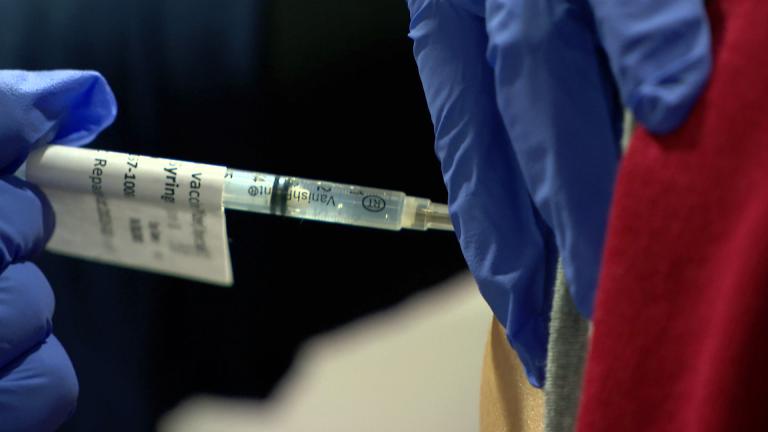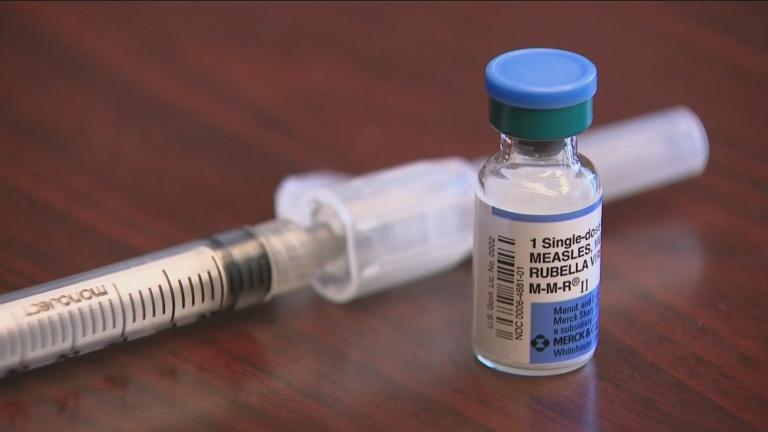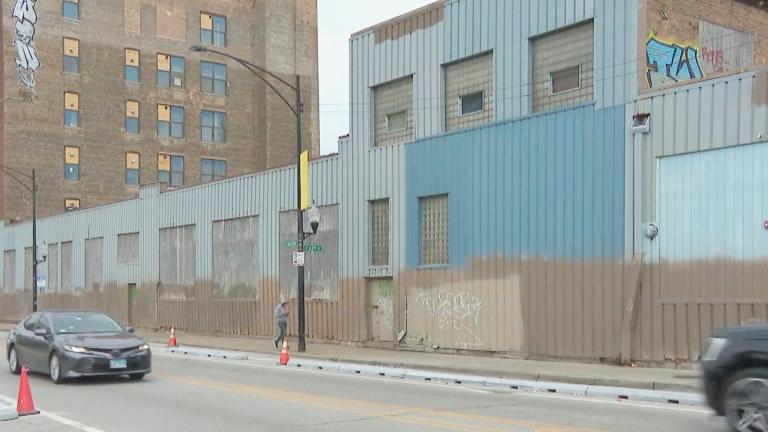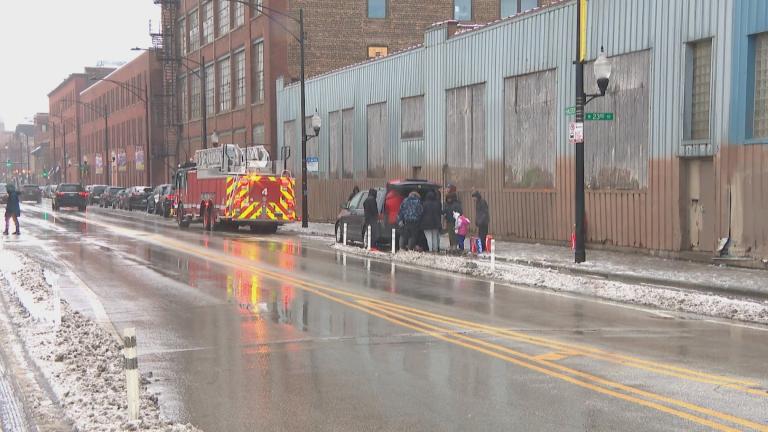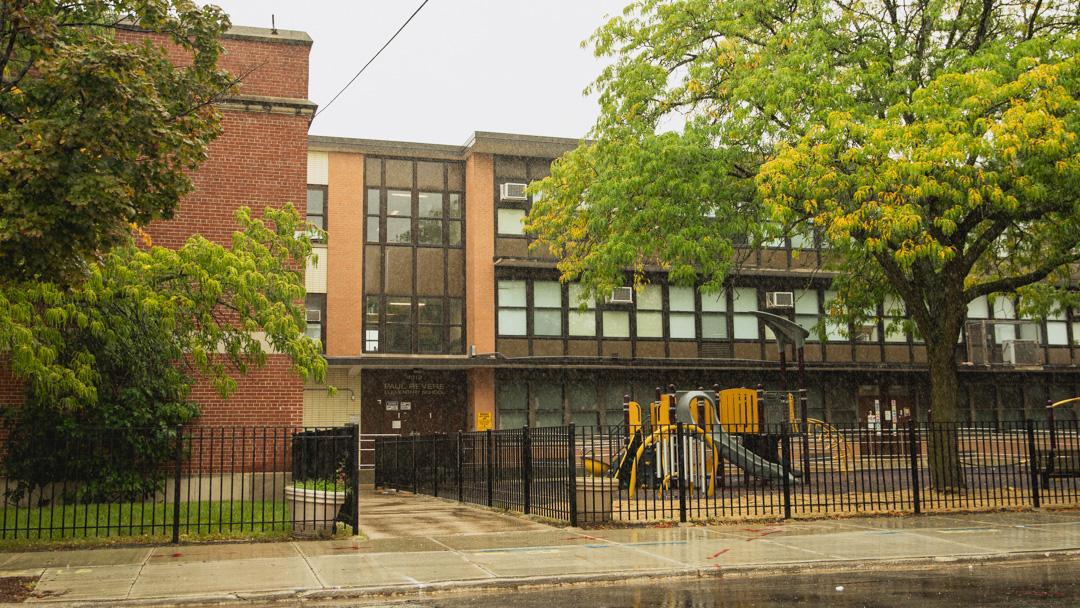 Paul Revere Elementary School, 1010 E. 72nd St., has a vaccination rate of 66% for measles, the lowest across Chicago Public Schools for the past school year. (Michael Izquierdo / WTTW News)
Paul Revere Elementary School, 1010 E. 72nd St., has a vaccination rate of 66% for measles, the lowest across Chicago Public Schools for the past school year. (Michael Izquierdo / WTTW News)
From supply lists to bus schedules, a new school year can bring plenty of stress before the first bell even rings.
Following a years-long pandemic, plummeting vaccination rates might give parents another problem to worry about.
Within the Chicago Public Schools district, almost half of the schools reported measles vaccination rates below 95% for the past school year, according to data from the Illinois State Board of Education. That mark is an important one, as measles, an extremely contagious disease with devastating consequences, requires about 19 of 20 people to be vaccinated to prevent its spread via herd immunity.
Districtwide, vaccinations rose to a high in the middle of the last decade for most schools. But a number of obstacles pushed numbers down during the pandemic for vaccines including measles, which is delivered as part of a combined Measles-Mumps-Rubella (MMR) shot.
“It’s a constant battle because you’re talking about vaccinating 1-year-olds and kindergarten-age children with two doses of the MMR vaccine,” said Marielle Fricchione, a pediatrician and member of the Illinois Chapter of the American Academy of Pediatrics. “A lot of life gets in the way of families getting their kids in for those two shots.”
Dropping Vaccination Rates
Measles, which can cause serious illness and death according to experts, has become more prevalent after it was declared eliminated by the Centers for Disease Control in 2000. Measles is especially dangerous to children younger than five, pregnant women and immunocompromised people, according to the CDC.
There were 1,274 confirmed cases of measles in the United States in 2019 across 31 states, including Illinois. That marked the highest number of cases since 1992, according to the CDC. There have been 19 measles cases reported to the CDC across the country so far this year.
A combination of economic factors, health access and misinformation pushed vaccination figures down to dangerous levels in recent years for many illnesses including measles, experts said.
A glimmer of positive news can be found in the 2022/2023 Illinois State Board of Education vaccination data, which looks better than previous years for many CPS schools.
Many families have a weaker support system in place including fewer choices for pediatricians in their area, and also could be under- or uninsured, experts said.
Records from ISBE where a count is available show a very strong relationship between the percentage of students in a CPS school classified as unhoused last school year and its measles vaccination rate. In other words, the higher the number of students experiencing homelessness, the lower the school vaccination rate is.
The McKinney-Vento Act allows children to register for school without a permanent address or vaccination paperwork. CPS and CDPH identified it as the leading category of vaccine exemption for the district in a written statement.
A 2021 report from the University of Chicago Inclusive Economy Lab estimated the district had about 18,000 students lacking a stable place to call home, and said 85% of those students identify as Black.
“The problems with CPS are fixable because a lot of them are due to access to health care over the past two years,” Fricchione said. “I am optimistic that once we solve that problem, we will be much closer to the herd immunity level.”
Measuring Vaccine Rates
State law requires schools to report data annually, but it measures vaccine compliance at a district level. The state benchmark counts how many people have completed paperwork rather than the actual protection rate, according to CDPH. The district’s nursing team collects data for immunization from families, and cross-checks it against the state’s immunization database for accuracy, CPS said.
“Because monitoring vaccination rates at the district level only, especially in a large district, can mask schools with low immunization rates that have a higher potential for vaccine-preventable diseases to spread, CDPH monitors vaccination rates at the individual school level. In terms of compliance and funding-levels, that is a State of Illinois policy and outside the purview of CDPH,” the department said.
Most school districts consist of a few schools at most, making it tough to compare to the sprawling CPS with more than 320,000 students in 634 schools.
“Yes, I absolutely think that it’s deceiving,” Fricchione said about the combined measurement of vaccination for a district.
The five CPS schools with the lowest measles vaccination rates are located in community areas with household poverty rates higher than the state average, according to Census data. The lowest measles vaccination rate for a CPS school in the past two school years was 15 points below where it was in the 2018/2019 school year, ISBE records show.
CPS “continues to make the health and safety of our students and staff our top priority while ensuring that students are provided with rigorous academic programming,” a district statement read. “The best way to support academic success is to minimize time away from school whenever possible.”
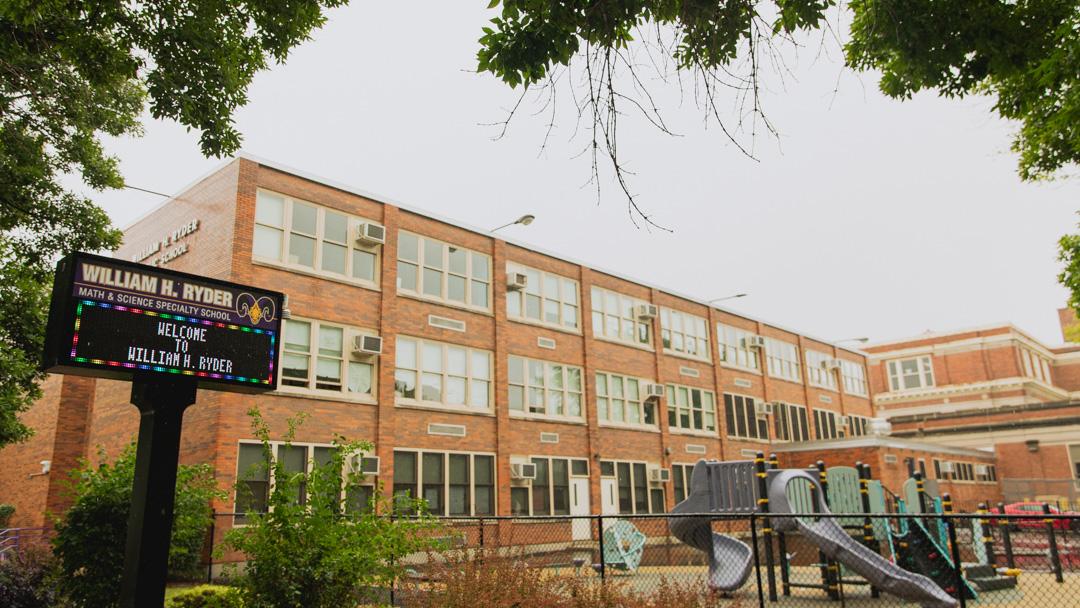 William H. Ryder Math and Science Specialty School, 8716 S. Wallace St., has a 100% vaccination rate. (Michael Izquierdo / WTTW News)
William H. Ryder Math and Science Specialty School, 8716 S. Wallace St., has a 100% vaccination rate. (Michael Izquierdo / WTTW News)
Vaccine Enforcement
Schools must exclude children from the population until they are compliant with vaccine requirements following the collection of records in October, according to ISBE spokesperson Jackie Matthews.
Approximately 1,000 students completed vaccination requirements or provided proof of exemption before returning to school during the 2022/2023 school year, the district said.
The city targets gaps in vaccinations through the federal Vaccines for Children program, which offers free shots to qualifying low-income residents. This program was partially created in response to a major measles outbreak between 1989 and 1991.
“Communities with higher economic hardship were more likely to have measles cases because they could not afford the MMR vaccine, or they did not have access to the MMR vaccine,” Fricchione said about local conditions at that time. “So those outbreaks were across the country, but were particularly bad in Cook County.”
CPS communicates vaccine requirements in many different ways. The district collaborates with Chicago Department of Public Health and partner-managed health centers to offer access to medical care, the district said in a written statement.
The district said it offered vaccination events, including 48 during the week of Aug. 14, and had vaccinations at each of the CPS Back to School events.
How CDPH will handle duties, including outreach to increase vaccination rates for city residents following a tumultuous month that included former Commissioner Allison Arwady being fired by Mayor Brandon Johnson, remains to be seen.
It’s not just measles that’s a cause for concern. Vaccination rates slipped for CPS schools for other serious illnesses during the pandemic as well, including polio.
Fricchione, who was formerly the medical director of the immunization program for the CDPH, was disappointed by a drop in vaccinations during the pandemic for human papillomavirus types that can lead to cancer because it reversed progress made against the disease, and she expects related cancer could increase because of it.
A recent report showed 2022 was the first year in about a decade HPV vaccination rates did not increase.
The last outbreak of a vaccine-preventable illness in CPS happened in 2018, the district said, resulting in 12 people developing pertussis, commonly called whooping cough.
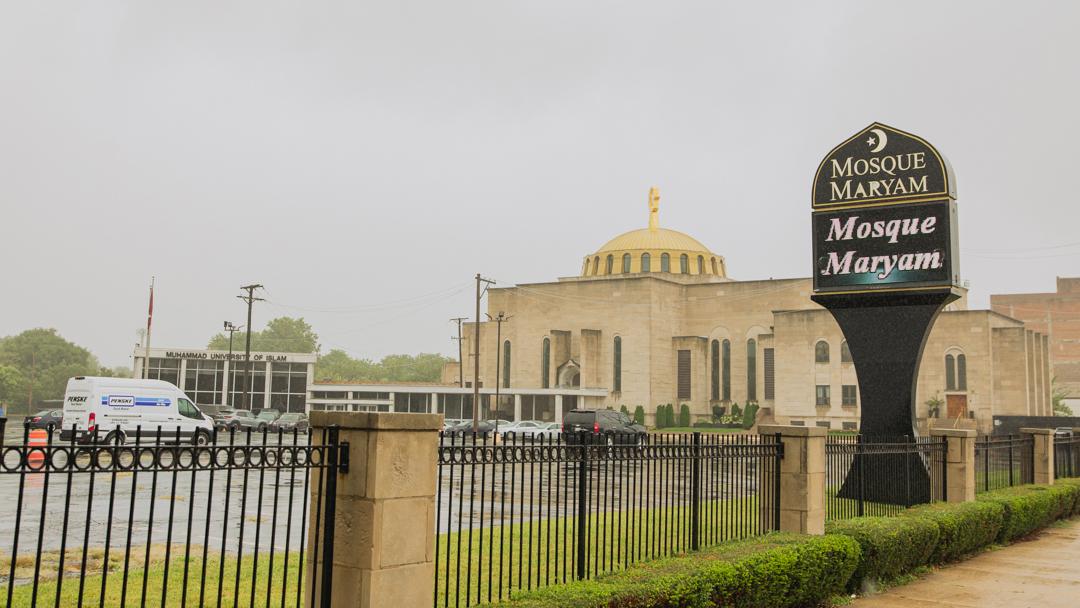 Muhammad University of Islam School, 7351 S. Stony Island Ave., reports a measles vaccination rate of 8% for the past school year. (Michael Izquierdo / WTTW News)
Muhammad University of Islam School, 7351 S. Stony Island Ave., reports a measles vaccination rate of 8% for the past school year. (Michael Izquierdo / WTTW News)
Role of Religion and Politics
It’s one thing to hear people talk about the importance of herd immunity in preventing diseases. It’s another thing to watch it happen.
An online epidemiological simulator from the University of Pittsburgh modeled the difference between a single case of measles introduced in Cook County with one side being 95% vaccinated and the other at 80% for school-age children.
A handful of infections happen in the 95% model, but on the 80% side, the disease spreads across the county in less than 240 days, leaving a trail of serious infection in its wake.
An estimated 128,000 people worldwide died from measles in 2021, mostly children under the age of 5, according to the World Health Organization. Complications for the disease include blindness, encephalitis and severe damage to the central nervous system, according to WHO and the CDC.
In Illinois, vaccine exemptions are allowed for religious or medical reasons.
Religious authorities in Christianity, Judaism and Islam broadly support vaccination, though the endorsement is not universal. Despite this, the highest rates of students unvaccinated for measles and other diseases in the state can be found at some religious schools.
The Muhammad University of Islam, a Nation of Islam affiliated school in the South Shore community area, reported 8% of its student body as vaccinated against measles last school year, according to ISBE data. In the 2017/2018 school year, the entire student body claimed a religious exemption for the measles vaccine. These exemptions were common for most required shots last school year.
The school is located about a mile from Paul Revere, the CPS elementary with the lowest measles vaccination rate in the past academic year.
The Final Call, published by the Nation of Islam, cites research by discredited individuals including Joseph Mercola, Robert Kennedy Jr. and Rizza Islam. These three were part of the “Disinformation Dozen,” spreading most of the false information about the COVID-19 vaccine, according to research by the Center for Countering Digital Hate.
Nation of Islam leader Louis Farrakhan also published campaigns against the COVID-19 vaccine.
Distrust in these communities is often buttressed by the fraudulent research of Andrew Wakefield, whose 1998 study falsely connected the MMR vaccine to autism, experts said. Despite being retracted following its publication, the damage from his work continues.
The Nation of Islam is a newer religious movement whose tenets developed outside the Islamic tradition of the Sunni and Shia branches. Its members often distrust ingredients in the shots, as well as pharmaceutical business models for testing vaccines, among other considerations.
“It has to do with, not necessarily religious values, but social concerns around vaccination that members of the larger African American communities with a history of racism also share around whether vaccinations are pure or safe,” Aasim Padela, an Islamic bioethicist and professor in the Department of Emergency Medicine at the Medical College of Wisconsin, said.
Other private schools also have low vaccination rates for measles in Illinois and the Chicago area.
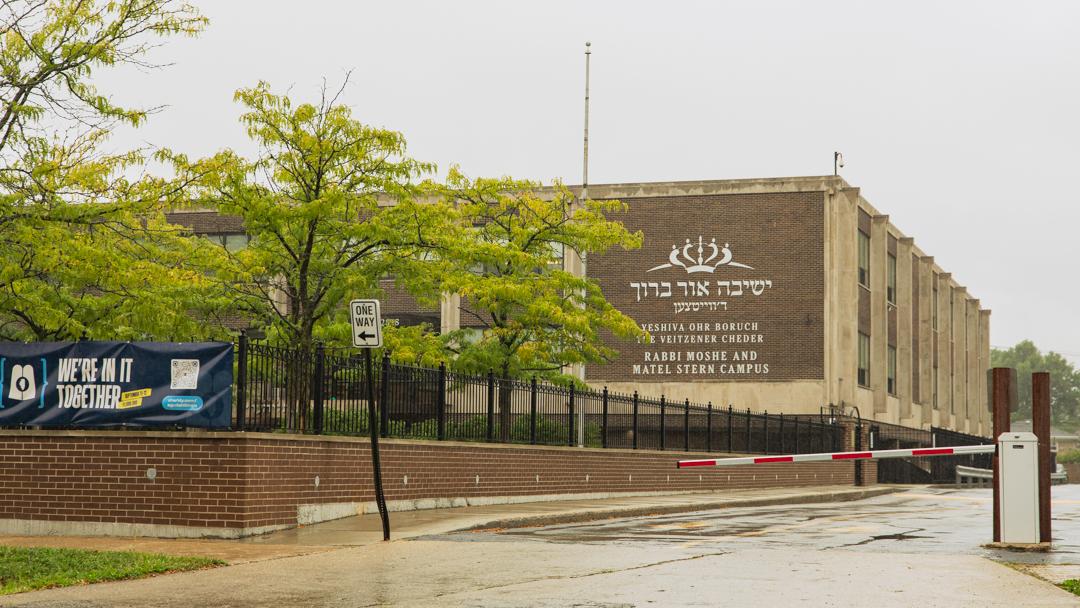 About a half of students at Yeshiva Ohr Boruch, 2828 W. Pratt Blvd., are vaccinated for measles, a figure the school’s dean disputes. (Michael Izquierdo / WTTW News)
About a half of students at Yeshiva Ohr Boruch, 2828 W. Pratt Blvd., are vaccinated for measles, a figure the school’s dean disputes. (Michael Izquierdo / WTTW News)
Only about half of Yeshiva Ohr Boruch, an Orthodox Jewish pre-K through 8th grade private school for boys, were vaccinated against measles, according to the report from ISBE. The school hovered around 85% for years before, but the vaccination rate dropped significantly during the pandemic, according to records.
In the 2019/2020 school year, the school reported 13 religious exemptions for the measles, polio, diphtheria, tetanus and pertussis vaccines to ISBE, according to records.
Dean Moshe Unger disputed the data, which was provided to ISBE by the school.
“That’s not correct,” Rabbi Unger said. “I can’t vouch for that. We have 360 students, and everybody is vaccinated.” Unger did not explain the apparent discrepancy.
Vaccine avoidance in conservative religious communities is connected to libertarian beliefs and a resistance to modernity rather than Jewish tradition, according to Laurie Zoloth.
“The idea of being vaccinated is a well-established discussion in Jewish legal and ethical terms,” Zoloth, a professor of religion and ethics at the University of Chicago, said.
The Jewish community practiced a precursor to vaccination in the pre-modern era, Zoloth said. Variolation protected against the disease and predated the smallpox vaccine by centuries. The same is true of Islamic communities in Turkey, according to Padela.
Risk is high in insular religious communities, where low vaccination rates can spread illness in the dense urban centers in which the communities live, and also can impact health care workers who treat the illnesses, Zoloth said.
A 2019 study published in the Lancet, a British medical journal, identified Cook County as having the country’s highest risk of measles because of international travel from countries experiencing outbreaks and non-medical vaccine exemptions.
Zoloth and Padela hope public health leaders can engage these communities in direct conversations to improve their rate of vaccination through tailored campaigns while trying to better understand the thought process behind some of the refusals.
“It’s sobering, actually,” Zoloth said about vaccine avoidance. “It’s a deadly kind of political turn.”
Vaccination Resources
CPS is continuing to serve as a safety net for students and families, and supplements the access to care offered by Chicago’s Hospital and Healthcare System.
The district’s Office of Student Health and Wellness (OSHW) encourages families to secure a Medical Home for their ongoing medical, behavioral and dental needs. Families can identify these supports by accessing the resources below:
Access to a Medical Home:
Access to School-Based Health Care:
-
CPS-Managed Vaccination Clinics
-
Mobile Health Coalition Providers for Immunizations and/or Physical Exams
-
School-Based Vision and Hearing Screening with Referral
-
School-Based Dental Examination
-
School-Based Optometry / Eye Examination
CPS communicates the state’s vaccination requirements with families through a variety of communications, documents and forms, including those found on the district’s Back to School website.
The Chicago Department of Public Health has a page about the federal Vaccines for Children program, which offers no-cost shots to qualifying residents.
CDPH offers standing and recurring vaccination clinics and events for children 0 through 18 years old with no out-of-pocket costs. A list with more information including locations and hours can be found here.
From the Illinois Department of Public Health: Minimum Immunization Requirements for Children Enrolling or Entering a Child Care Facility or School in Illinois, 2023-2024.
IDPH publishes a number of resources, forms and publications about vaccinations.
The Centers for Disease Control offers vaccine information through programs including its Advisory Committee on Immunization Practices.
The CDC also offers a Child and Adolescent Vaccine Assessment Tool that helps identify vaccines that protect from certain high-risk, medical or living conditions.
Contact Jared Rutecki: @JaredRutecki | [email protected]

